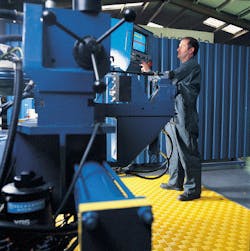Integrating Safety: Using a Safety Portfolio to Improve Bottom-Line Performance
In the U.S., where industrial safety is considered sacrosanct, some companies, while using safety standards as guidelines, still do not make machine safety a top priority. Ironically, some manufacturers are falling short on safety due to a tragic lack of knowledge about how safety equipment and the integration of safety solutions have evolved in recent years. This evolution allows safety equipment to be easily and economically integrated in the automation system design process at the earliest stages of development.
Today, integrated safety solutions can be leveraged to maximize productivity and improve bottom-line performance. Unfortunately, many companies are cowed by the upfront costs associated with safety, which, by some industry estimates, adds no more than 2 to 5 percent to the cost of an automated system.
The upfront costs, of course, are negligible when weighed against the risks associated with not building safety into automation systems. “If safety is not integrated early in the machine life cycle, the risk a company is exposed to includes potential harm to their employees, lost work time of the employee due to injury, lost production due to after effects of an incident, and lack of productivity because the machine has not been optimized to run safely and must be stopped to be repaired and adjusted,” says Michael Miller, safety business development manager for Rockwell Automation (www.rockwellautomation.com).
By not leveraging the latest safety standards that allow for safer, more productive operations of machinery, manufacturers are putting themselves at a clear competitive disadvantage, not to mention exposing themselves to government sanctions and penalties. Failing to incorporate safety in the design process, as Miller states, can lead to reduced effectiveness of the machines and those who operate them.
The good news for manufacturers is that recent developments in the specification and procurement of safety systems—such as the availability of comprehensive safety equipment portfolios—now provide manufacturers with a turnkey approach to integrating safety in machine design. The availability of one-stop, turnkey safety portfolios have made investing in safety systems simpler and more cost-effective. Rockwell Automation, for instance, delivers an integrated safety portfolio of products that seamlessly harmonizes all the safety apparatuses into one solution architecture with common tools and training. The Rockwell Automation safety portfolio promises to speed up the deployment of safety systems and lower the overall cost of ownership of machines. Further, the Rockwell Automation safety portfolio provides the tools and expertise to assist manufacturers in shaping safety solutions that support both manufacturing and safety goals.
The benefits of the safety portfolio approach are multifaceted. Miller explains, “When a company uses the latest safety technology offered by Rockwell Automation’s broad safety product portfolio of services, systems, and components, they allow their operators and maintenance people to maximize their productivity and efficiency while working near or in hazardous situations. The Rockwell Automation safety product portfolio allows companies to maximize their plants’ productivity while maintaining a higher level of safety, thereby maximizing productivity of their workers and machines, minimizing downtime occurrences and reducing the ‘time-to-repair’ when there is an outage or disruption in production.”
Miller adds, “When a systematic process of reviewing the limits, functions, operations and repairs of the machine is followed, the hazards and risks associated with those hazards can be identified and mitigated. This allows the designer and his or her team to integrate safety early in the design process. The advantages this offers to the designer are many. First, he or she can eliminate the hazard or significantly reduce the potential for harm associated with the hazard. Second, the designer can integrate a contemporary safety solution into the machine that will provide the appropriate level of safety to the hazard identified. Third, the designer can maximize the machine’s productivity by minimizing the time-to-repair due to the occurrence. This allows the designer to maximize the productivity of the machine, line and plant while maintaining the highest level of safety, and reducing the total cost of ownership during the life of the machine.”
As Miller asserts, the benefits for manufacturers moving to truly integrated safety solutions are enormous. Clearly, hardware utilization and worker productivity are enhanced when safety is integrated early in the machine life cycle. However, another important benefit of an integrated approach to safety is a reduction in the cost of software and support. Additionally, scalability becomes easier to manage because engineers can readily deploy and distribute the necessary safety hardware to meet application demands, whether on an individual machine or across the entire enterprise.

